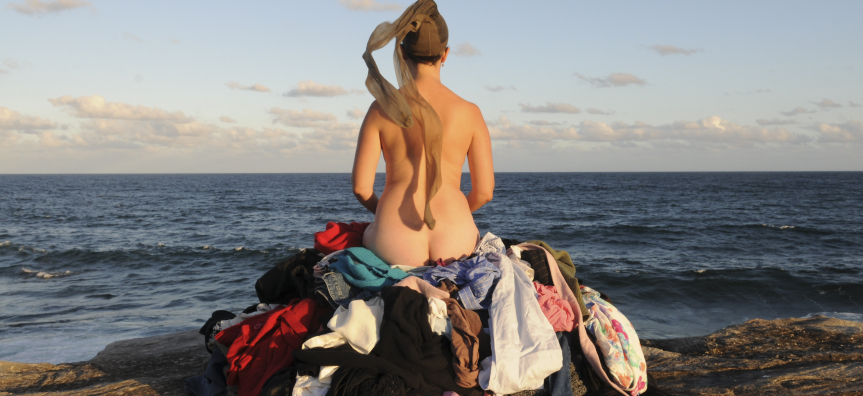
Katthy Cavaliere, Nest 1, 2010 (printed 2016), chromogenic colour printed print on silver based paper
Explore a selection of key works from across MAG&M’s collections that illuminate the work of significant Australian artists, and tell stories that reflect upon ideas, issues, landscapes and country.

pastel, pencil, glitter, Swarovski crystal on paper, 73 x 98cm. Courtesy the artist and N.Smith Gallery, Sydney
This large work on paper provides a unique perspective on the artist’s practice. Danie Mellor (b.1971) draws from his Indigenous heritage to examine Australia’s unique cultural histories. He is of Scottish and Aboriginal descent – his maternal forebears hailing from the Mamu, Ngagen and Ngajan peoples of Queensland’s Atherton Tablelands. Delving into the tensions of his own ancestry, Mellor articulates a post-colonial history of Australia.
Mellor represents this hybridity in his work through the motif of Enlightenment-era depictions of non-European cultures, such as the Chinese-inspired willow pattern of late-18th century porcelain. Borrowing the styles of 18th-century prints and engravings to depict Australian animals and Aboriginal people, Mellor mines the tension between the Enlightenment’s call for the universal rights of man and the project of colonisation, both of which occurred simultaneously in Australia.
MAG&M also holds a ceramics work The Millstream – a shield, 2006, which depicts a background of land survey markings and is glazed in contemporary colours which relate directly to the cartographic methods of the modern era. It shows Mellor’s distinctive use of materials and mediums by casting a ceramic version from a shield which was originally made of steel – successfully integrating the traditional indigenous symbolism of his ancestors into contemporary culture.
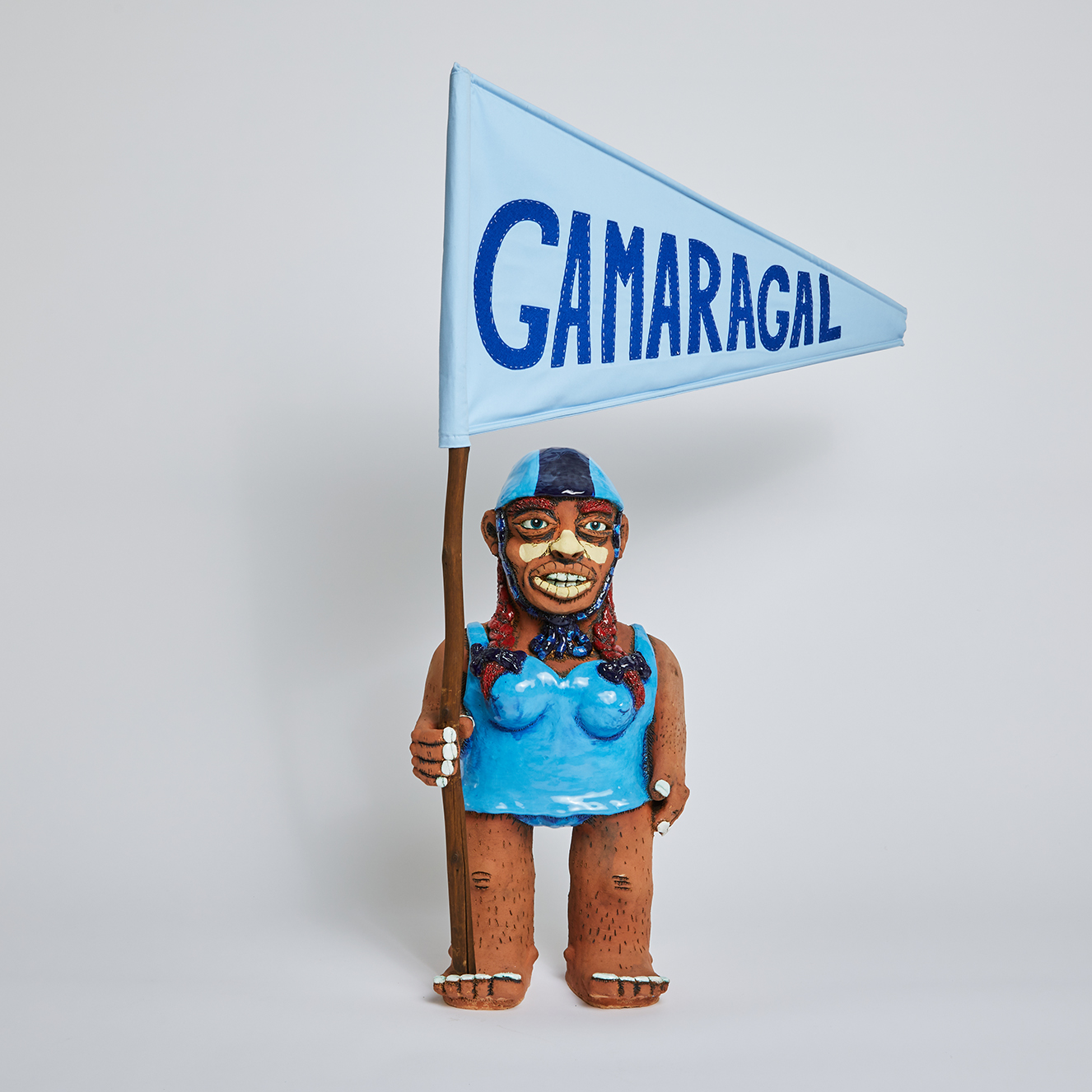
Terracotta with underglaze and glazes, 76 x 37 x 25cm
Billy Bain is a proud Darug man and Northern Beaches local whose art practice spans ceramics and painting. MAG&M and MAG&M Society joined forces and resources to purchase ‘Dawn’, the flag bearer in his installation titled ‘March Past’ and a key work in his solo exhibition.
The March Past is a traditional team event held during surf lifesaving carnivals. Heavily influenced by marches performed by military servicemen, the March Past represents the discipline of surf life savers. The march is led by the bearer, who carries the flag which signifies which club or beach the march is from.
Bain posits that “the March Past is a ritualistic and militant performance of colonial ownership over the beach space. The act of using a flag to signify ownership of place is inextricably linked to Australia’s colonisation. Bain places Indigenous figures in the March Past carrying a flag emblazoned with the name of the original custodians of the Manly area. The work implies a reclamation of the beach space which was never ceded.”

Oil on board, 30 x 36cm
We are so lucky at MAG&M to be located on the water and within a community that cares for our natural environment. Harold's Greenhill's (1914 - 1995) 'The Spit' highlights the beauty of our local waterways as do so many other works in our collection.
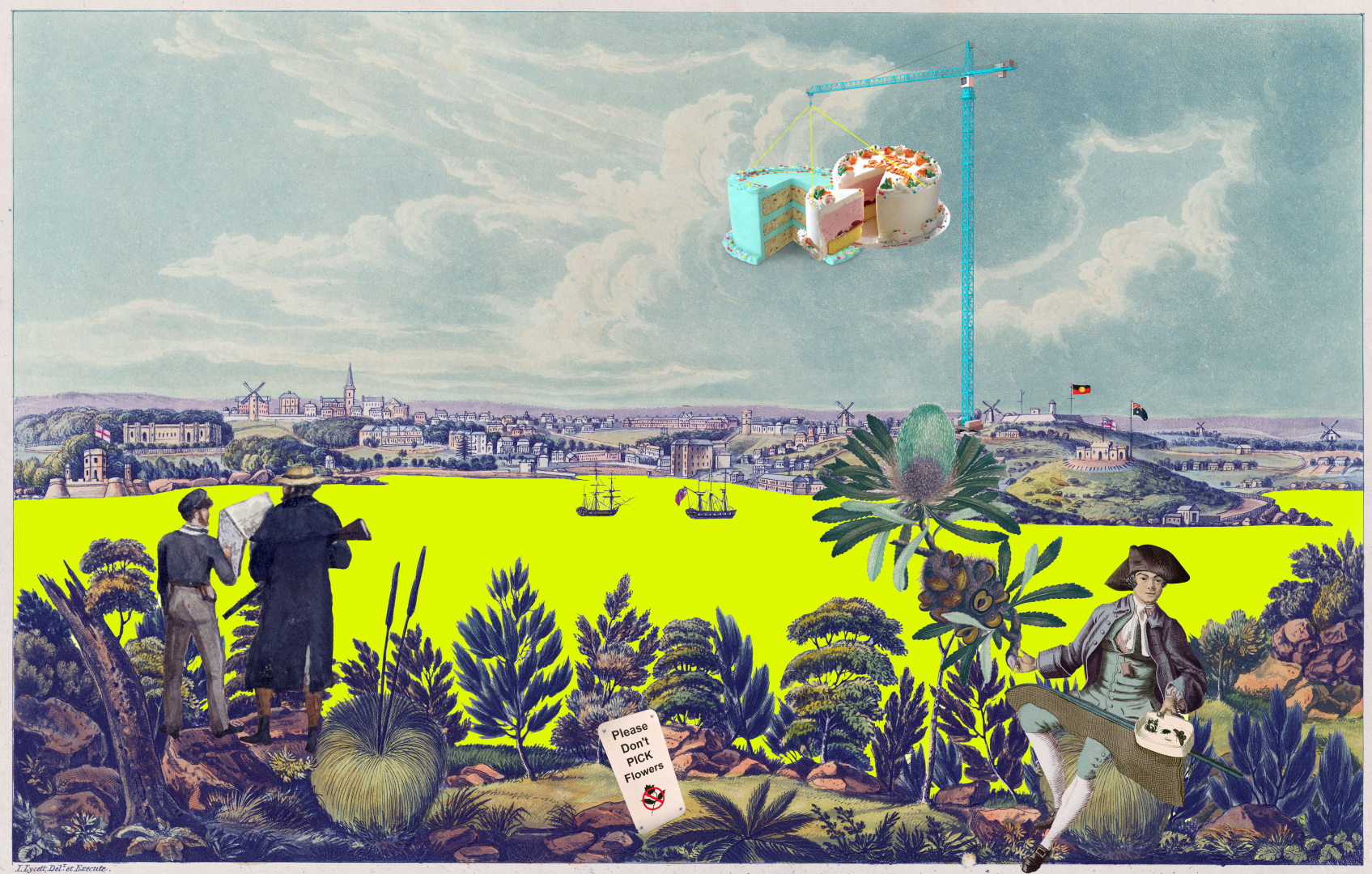
Hand coloured pigment print on cotton rag paper, 83 x 118cm
Joan Ross’ artworks often combine colonial iconography and landscape painting with montaged symbols of western culture. They examine the imposition of colonialism in Australia, especially concerning its effect on indigenous Australians, drawing attention to the complex and ongoing issues surrounding first contact. The use of fluorescent yellow and high-visibility clothing in Ross’ work symbolises colonisation, highlighting the foreign disruption of western culture into the natural order of this place.
The relevance of the title of this work, Please don’t pick flowers, resonates in Manly as the picking of native flowers in the area, especially at North Head, for the annual ‘Manly Wildflower Show’ (1881-99) led to the widespread destruction on native flora. MAG&M purchased this work in 2019. Ross’ work also currently features on the Sydney Modern hoarding at the Art Gallery of NSW.
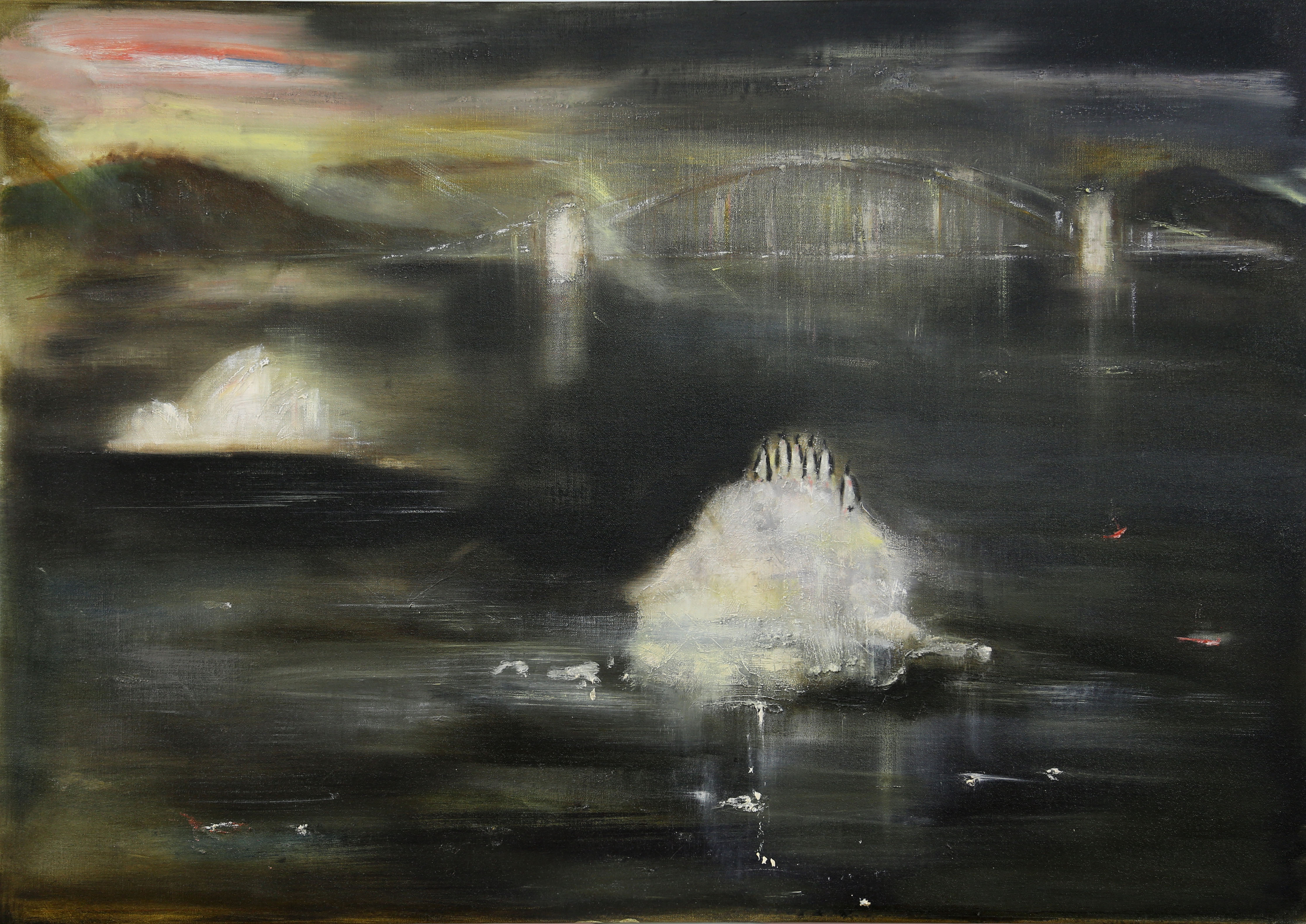
Oil on linen
Rodney Pople (b.1952) is an interdisciplinary artist who works across various mediums including painting, photography and sculpture. Sydney Harbour is a significant recent work by this Sydney artist, and is a most welcome and generous donation by Felicity Fenner.
In this painting, a group of penguins is shown stranded on an iceberg in Sydney Harbour. The iceberg, the Opera House and the Harbour Bridge glow with a light that seems to somehow emanate from behind the dark canvas. This kind of mysterious, almost dream-like scene is typical of Pople’s paintings.
The subject matter of this painting is also relevant as one of MAG&M’s collection foci is Sydney Harbour.
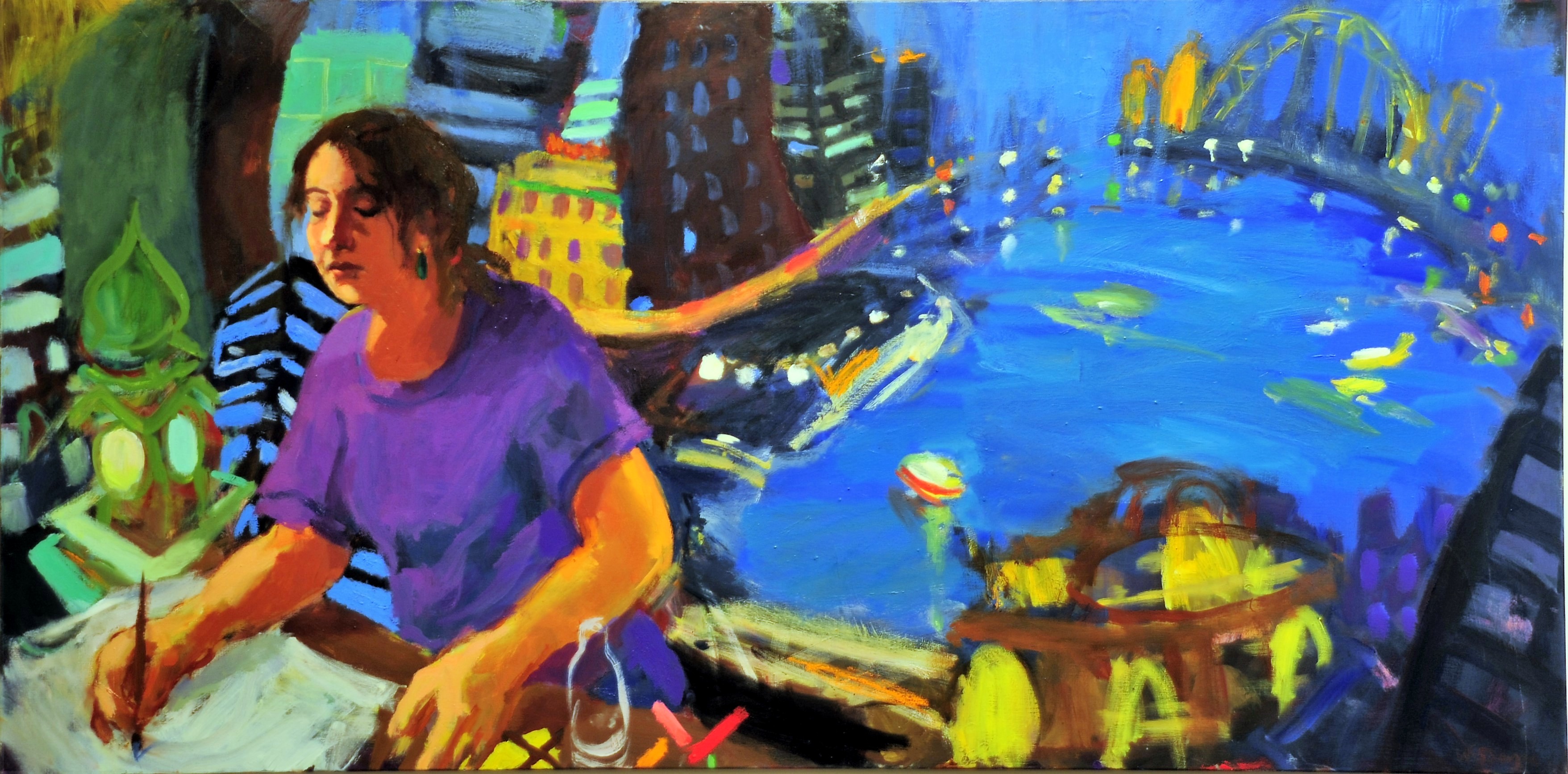
Oil on linen
'Blue Harbour' by Archibald Prize-winning artist, Wendy Sharpe (b.1960), with its vast view north across the Harbour, incorporates a self-portrait of the artist herself amidst some of Sydney’s key landmarks - the Harbour Bridge, Customs House and Circular Quay - illuminated and shimmering at night. Sharpe created this work by first making small sketches in pencil and gouache during her artist-in-residency at a law firm on Bligh St, with a harbour view. Working the sketches up into the vibrant and colourful 'Blue Harbour' painting back in her studio, Sharpe remarked that “at night everything looks more magical and mysterious”.
The painting was donated by the MAG&M Society to mark the Gallery’s 90th birthday in 2020.
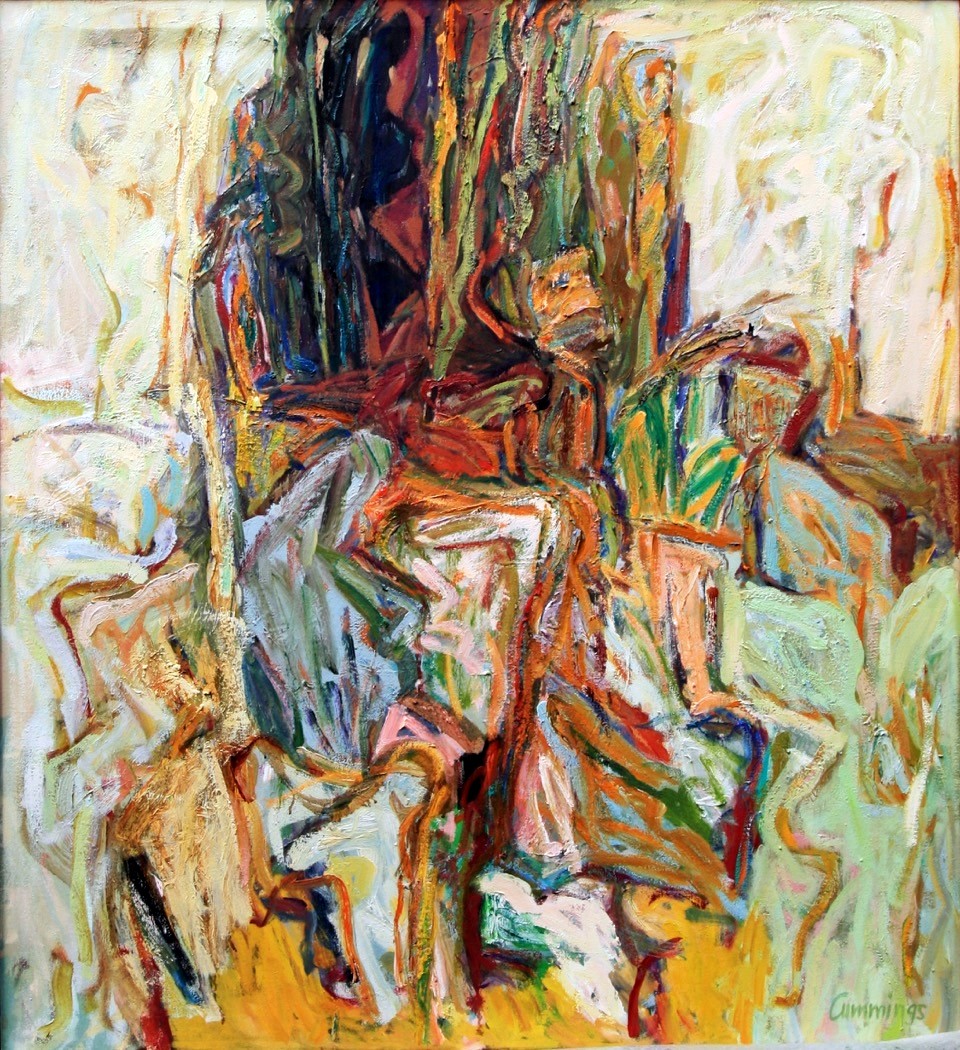
Oil on canvas, 122 x 112cm
Elisabeth Cummings (b.1934), is one of Australia’s most respected painters who has spent the last sixty years developing work that shifts between abstraction and figuration, inspired by the Australian bush yet drawn from memory. Her contribution as a teacher at the National Art School for thirty years from 1969 and as a member of the Wedderburn artists’ colony have contributed significantly to the story of Australian art.
Untitled, 1984 is a very good example of the abstract nature of Cummings’ landscape paintings during the early 1980s. MAG&M is very pleased with the generous donation by Peter Boehm. It complements MAG&M’s current holdings of two small paintings from the 1970s and four more recent etchings. MAG&M has featured Cummings’ work in two major exhibitions; Destination Sydney in 2015 and Harbour Life in 2008.
Cummings’ large paintings are distinguished by impastoed surfaces and ebullient colour. At the time this was painted, the artist was living and working extensively in her studio at Wedderburn NSW, paying very close attention to her surrounds. The property is mostly native bushland and, except for the studio and its immediate surrounds, nothing much has altered the look of the landscape. Judging by the rich colour, it suggests Springtime and the richness of the growing season. It also depicts Kenny's dam which is at the end of the walking track near the property.
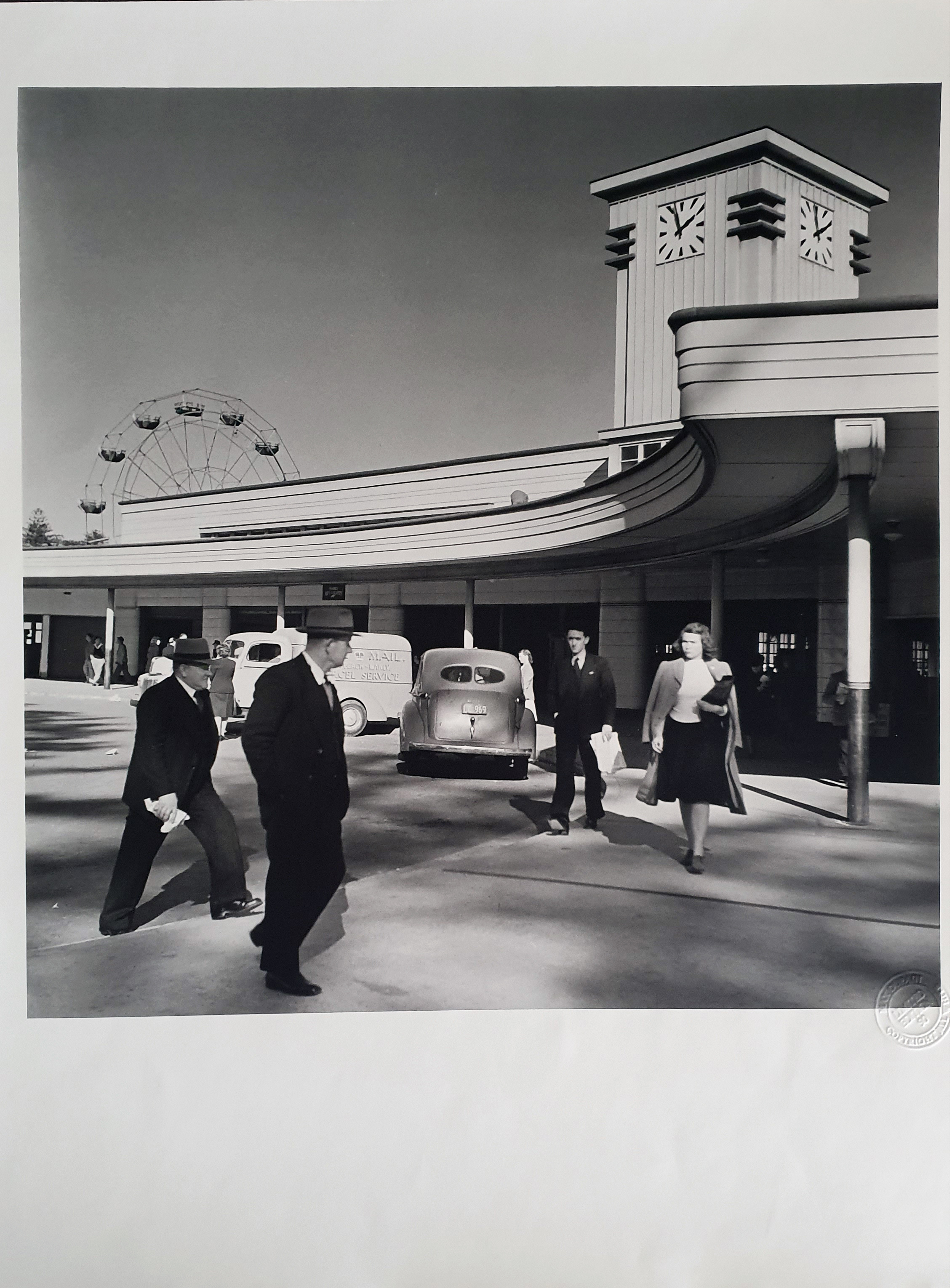
Photograph, Copyright Jill White
Max Dupain was an Australian modernist photographer, receiving his first camera as a gift in 1924. Dupain studied at the East Sydney Technical College and the Julian Aston Art School, while he apprenticed with commercial photographer Cecil Bostock. By 1934 he had established his own studio in Sydney. In 1939 Dupain married Olive Cotton, also a photographer. His work was featured in numerous exhibitions and retrospectives, and he was made an Officer of the Order of the British Empire in 1982.2 Max Dupain’s photographs are characterised by a strong sense of design and composition and are a consciously modern view of the beach. MAG&M owns nine works by Dupain, purchased from its 2002 exhibition, Max Dupain’s Manly. The scene below depicts Manly Wharf in the 1940s.

Oil on canvas, 52 x 36cm. Gift of Colonel Alfred Spain, 1940
Tom Roberts is one of Australia’s best known and most closely studied artists. Roberts came to Australia in 1869 at the age of 13 with his widowed mother and settled in Melbourne. He first gained his artistic training working part time as a photographic assistant while studying at the Collingwood School of Design and the National Gallery.
At the age of 25 he sailed to England where he spent four years at the Royal Academy School, London. During his five years overseas he also travelled to Europe and visited the galleries in Spain, France and Venice. Throughout his artistic career he returned to London, keeping up with overseas artistic developments. He was knowledgeable about academic figure-painting, open air tonal painting, Realism, Naturalism and Whistler’s artworks and French Impressionism.
Inspired by his artistic knowledge and skills gained from his European travels, Tom Roberts was determined to capture the characters, events and an atmosphere that was identifiably Australian. Roberts painted the great themes of Australian life at the time: immigration, shearing, stock riding, logging, threshing, bush ranging, outdoor recreation and bustling city life. He travelled the continent more extensively than any other major Australian artist of his time.
‘Christmas flowers and Christmas Belles (The flower sellers)’ evocatively depicts the vitality of Sydney’s King Street. By sharply contrasting the sun bleached ochre tonality of the street with the dark figures of the flower sellers, he portrays a summer mid-afternoon sun. It was revealed with the aid of blue light that the artist had removed a standing woman and running child in the area left of centre of the painting. The figures can still be seen in the lithograph issued in the Sydney Mail in 1899 of which the Gallery has a copy. You may still be able to see the ghostly remnants of the figures in the painting. This work has been exhibited in many key exhibitions including: Tom Roberts Retrospective (AGSA 1997-98) 1900: Art at the Crossroads 2001 (Royal Academy - London 2000, Guggenheim Museum - New York 2001), Sydney at Federation (Museum of Sydney 2000-01).

Oil on canvas, 81 x 102cm. Gift of the artist, 1934
Manly Summer is Here is a dynamic and highly evocative painting in MAG&M’s collection. Carrick Fox was a significant artist who spent the majority of her lengthy art career in the shadow of her artist husband, Emanuel Phillips Fox.
Originally from the United Kingdom, trained in London and exhibiting early with the Royal Academy of Arts, Carrick met Phillips Fox in 1903 at a plein air painting camp in St Ives, Cornwell in England. They spent much time travelling in France and Northern Africa undertaking lengthy plein air trips documenting the culture and landscapes of the ‘exotic’ eastern civilisations of the North African region. Phillips Fox’s Moslems in Procession (also in the MAG&M collection) underpins this fascination with the exoticism and ‘otherness’ of eastern cultures and religions. Carrick Fox’s highly Post Impressionist painting style suggests a fast paced plein air painting technique, designed to capture many aspects of an outdoor scene.
In Manly Summer is Here, Manly Beach is packed with people of all ages soaking up the rays of the sun, swimming or resting with swimming costumes signifying quite restrained attitudes to public bathing at this time in Australian culture. Carrick Fox asserts a strong commentary about the status of male and female roles at the time towards the end of the Edwardian Period. This is demonstrated through the state of dress of the subjects, the English traditions of beach bathing, deckchairs, umbrellas and full dress for women. Manly Summer is Here is an ironic social comment on Australia’s repressive by-laws against mixed bathing, showing women clothed neck to knee sitting passively in deckchairs or guarding their children while their menfolk flex their muscles in the surf.
Whilst Carrick Fox’s own personal situation and upper class status enabled her relative freedom to pursue her art, freed from the burden of work or family, paintings such as Manly Summer is Here documented the resort atmosphere of Manly as beach destination, but her painting makes an insightful social statement about the gender balance at this time in Australian society. It was also at this time, through her own spiritual interest in Theosophy, that Carrick Fox was embraced by a community that welcomed her, in contrast to the antipathy from her husband’s family in Melbourne. Whilst with these families on the North Shore and Northern Beaches of Sydney, Carrick Fox produced a number of works on the harbour and beach with intensive crowd scenes and dynamic movement and activity.
Manly Summer is Here was taken to France by Carrick Fox where it was awarded the Gold Medal in Bordeaux 1926 and the Diploma of Honour in 1926. Despite her prolific career, Carrick Fox spent a great deal of time championing her late husband’s work overseas following his death in 1915 and she often referred to her work as the ‘younger sister’ of late husband E Phillips Fox’s work.3 Following her death in 1952, Carrick Fox’s works have achieved increased admiration and value on the Australian and international markets.

Oil on canvas, 77 x 92cm. Gift of the Manly Art & Historical Committee, 25 October 1924
This is one of the most significant paintings in the Gallery’s collection, being the first, and a major painting by Sydney artist, James Jackson (1882-1975). It formed the nucleus of the Manly Art & Historical Collection in 1924, having won the inaugural Manly Art Exhibition organised by the owner and editor of The Manly Daily, Joe Trenerry, who was also a patron of the arts and a local Manly Councillor. The competition paintings were exhibited in a large marquee in the park outside Manly Council Chambers.
Several artists and local residents successfully lobbied Manly Council to purchase Jackson’s winning painting in the hope that it would become the core for an art collection, eventually to be housed in Manly’s own Art Gallery. They requested that the Mayor do ‘all in his power to retain this beautiful picture for the citizens of Manly’ (letter dated 14 January 1924). A citizen’s committee raised 100 pounds to purchase the work which lead to several other artists and donors contributing works to the fledgling collection.
Middle Harbour from Manly Heights, 1923 is one of many paintings in which Jackson depicts Sydney Harbour and its environs. It is an important work, both historically for the scene it captures and for what it demonstrates in his stylistic development. It depicts the sparse, open landscape of Seaforth before the new bridge that linked Mosman with Seaforth was built and which opened in February 1925. The influence and integration of his broadening landscape style is evident in his use of wide and rhythmic land masses, leading the eye up Middle Harbour to distant suburbia - all under a hot, late-summer sky. This painting is a joyful interpretation of Middle Harbour, revealing the artist’s passion for beauty and fascination with the landscape. His knowledge of pattern and mass gave him the skill to render the ‘atmosphere of the picture’ which resonates through the painting and remains a source for continuous pleasure for viewers.
James Jackson was a foundation member of the Australian Academy of Art and at the time he created this painting, he was a teacher at the Royal Art Society School. He was also married to fellow artist Dora Toovey, whose work is represented in the Gallery’s collection, and they were living in the house and studio Jackson built in Battle Boulevard, Seaforth, overlooking the Spit.
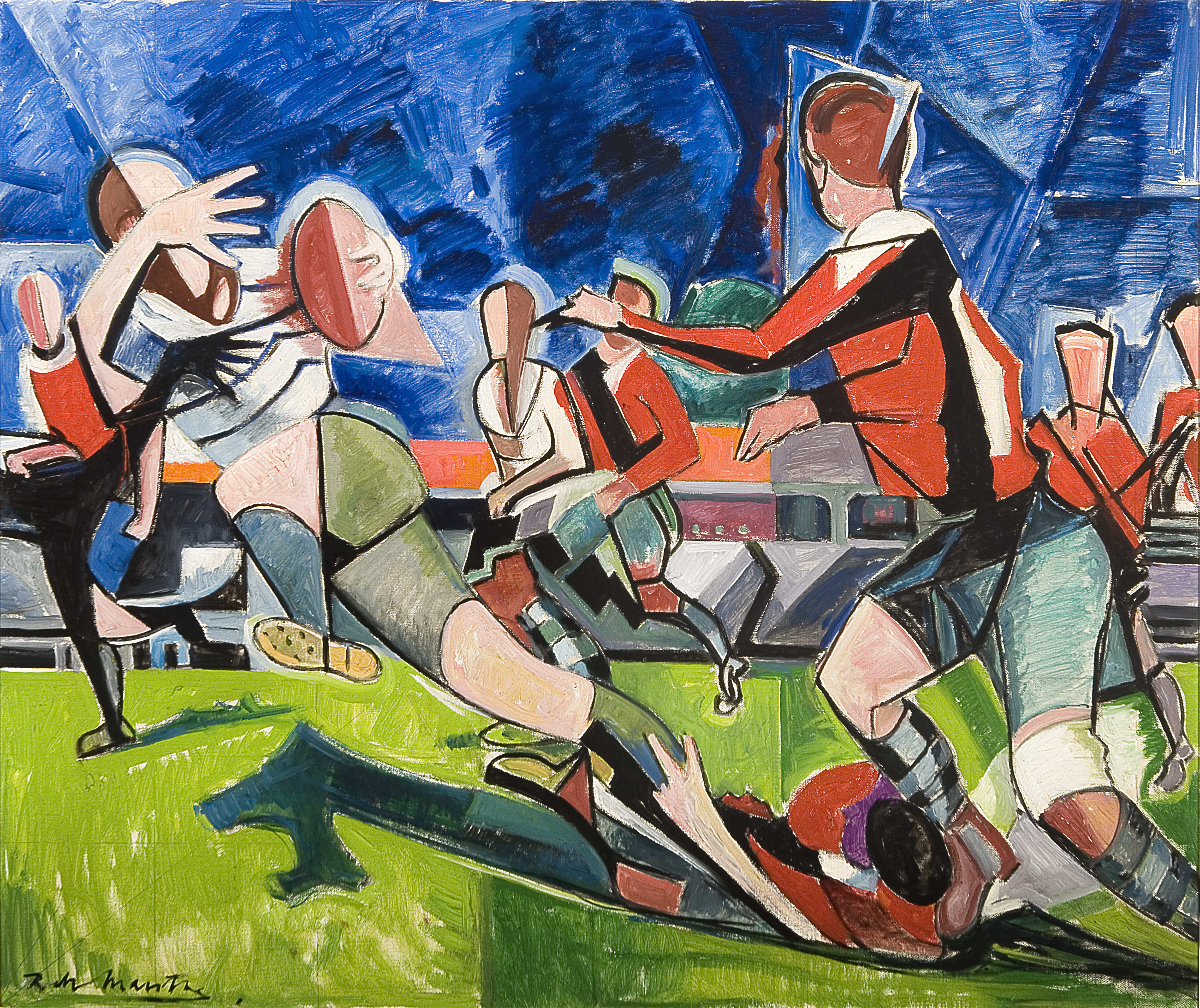
Oil on canvas, 64 x 76cm, MAG&M Collection - Purchased with assistance from the NSW Ministry of the Arts, 1984
This painting from the collection by Roy de Maistre is currently on display in MAG&M’s Fair Play exhibition (9 Dec 2022 – 26 Feb 2023).
Roy de Maistre (1894-1968) attended Julian Ashton Art School prior to 1923 and then The Royal Art Society School where he was taught by Antonio Dattilo-Rubbo and Norman Carter. He also studied music at the Conservatorium of Music in Sydney. Therein lies the connection between music and art as an interplay between de Maistre’s art practice for much of his art career.
Under Rubbo’s tutelage, de Maistre and fellow students Roland Wakelin and Grace Cossington Smith were encouraged to experiment with colour and form, and to embrace the techniques and philosophies of Post-Impressionism emanating from Europe in the late 1880s. De Maistre was interested in techniques and concepts of music and colour theory. He went on to developed seemingly ‘radical’ works for the time that embraced art, music and psychology.
In his later years, de Maistre had a strained relationship with Australia which he believed resisted his attempts at modernism due to its conservative creative environment. In 1930, he moved to the United Kingdom and in London and was acquainted with Patrick White who became a friend and collector, and Francis Bacon who cited de Maistre as a significant influence in his own art practice.
The Match was painted by de Maistre in 1933 and featured in a 1948 exhibition at London’s Victoria and Albert Museum ‘XIV Olympiad Sport in art exhibition’. While the painting was created in the UK, its subject matter of rugby clings strongly to the Australian ways of being. The work is angular and fast moving - the faces of the players are unrecognisable. The swift movements of the players jars against a brilliant blue sky and bold coloured sporting ground. The Match embodies de Maistre’s Cubist principles and philosophies of high keyed colour and tone and his adherence to geometric form and composition.
